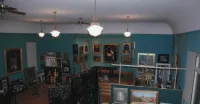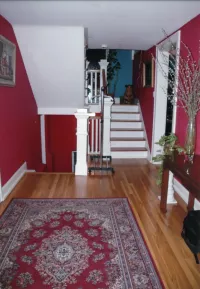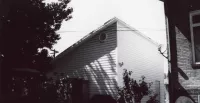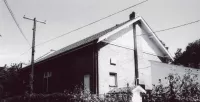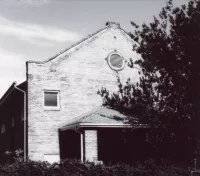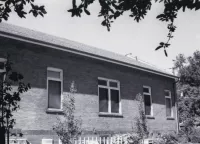Share what you know,
and discover more.
Share what you know,
and discover more.
Feb 06, 2007
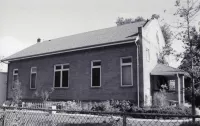
-

- Charmaine Bantugan
National Register of Historic Places - Seventh-day Adventist Meetinghouse and School
Statement of Significance: The Seventh-day Adventist Meetinghouse and School, located at 1840 S. 800 East in Salt Lake City, Utah, is a brick building originally constructed in 1928 in a simple modified Mission style. The building is significant under Criterion A for its association with the early twentieth-century social history of the evangelical and educational mission of the Seventh-day Adventists in Utah. The Seventh-day Adventists came to Utah in the 1890s, about twenty years after other Protestant denominations. With an active proselytizing and education program, the Adventists had moderate success in the larger cities of predominantly Mormon Utah in the late- nineteenth and early twentieth centuries. Because of the dominance of the Church of Jesus Christ of Latter-day Saints in the state and region, there are relatively few examples of historic meetinghouses of other faiths. This building is the earliest of only three known extant historic Seventh-day Adventist Church meetinghouses in Utah and represents the progress of the Seventh-day Adventists in the early twentieth century. It was the main worship space in Salt Lake City for three decades and also housed a day school, one of the Adventist Church's most important programs. The building was sold by the Adventists in 1968 and is currently an artist's studio and residence. The building is in excellent condition and is a contributing historic resource in Salt Lake City. History of the Seventh-day Adventist Meetinghouse & School The property is located within the East Bank Addition, a subdivision developed by James R. and Elizabeth A. Smith. The subdivision plat was filed on January 18, 1893. The Eask Bank Addition was a small twenty-lot development, which bordered Parley's Creek on the south and Downington Avenue on the north. For many years, lots 7 and 8 of Block 2 were owned by Catherine and James McDonald, who lived in a small frame house on the corner. On March 27, 1929, the property was sold to B. W. and Annie Brown, who facilitated the sale to the Pacific Union Conference Association of Seventh-Day Adventists in April 1929. Salt Lake City building permits were secured in the summer of 1928 and the address first appears in the 1929 Salt Lake City directory so the building was probably under construction before the title was transferred to the church. The Seventh-day Adventist Church had its beginnings in the nineteenth-century preaching of New Englanders, William Miller, Joseph Bates, and Ellen White. The name Seventh-day Adventist was adopted by the church in 1860 and reflects the organization's belief in the imminent Advent of Christ. The headquarters of the church was located in Battle Creek, Michigan, and the evangelical mission of the church was conducted from that location nationally and internationally in the late nineteenth century. The first Adventist Church established in the western United States was in Petaluma, California, in the spring of 1868 (the Pacific Union Conference). By 1878, the congregation in Reno, Nevada, was established. In the 1880s, Seventh-Day Adventists founded branches in Arizona and New Mexico. While early newspaper articles indicate that Utah residents were aware of the Seventh-day Adventist Church in the 1870s, there appear to be no formal congregations in Utah until 1890. Like other Protestant denominations, the Adventist Church eventually organized a mission to proselytize and educate members of the Church of Jesus Christ of Latter-day Saints (LDS or Mormon) Church in Utah. The Seventh-Day Adventists arrived in Utah somewhat later than the older, more mainstream Protestant denominations, but had established a congregation in Ogden in 1893. The Adventist Church was holding camp meetings and baptizing converts in Salt Lake City by 1896. A study conducted in 1938 by the WPA provides a statistical look at the Adventist Church in Utah in the historic period. The study indicates a modest growth over a forty-year period: 1890 (organizations, 2/membership, 37); 1914 (organizations, 7/membership, 205); 1926 (organizations, 6/membership, 290); and 1939 (organizations, 9/membership, 500). In Salt Lake City, the first church building was located at 579 E. 500 South (demolished). There was a day school at this location as early as 1904. Later a day school was built at 480 S. 600 East (demolished). A December 18, 1926, article in the Salt Lake Tribune notes services in the Liberty Park (probably 500 South) and Sugarhouse areas, but it is unknown where the Sugarhouse congregation was meeting. It is possible they were meeting at the older residences at 1840 S. or 1852 S. 800 East since the church had an interest in the property before purchasing it in 1929. There was also a bungalow on the property at 772 E. Downington Avenue (circa 1920). The 1926 article also notes that the Seventh-Day Adventist Church would be constructing a chapel for the "colored members of the faith." This building is located at 822 S. 300 East in Salt Lake (built-in 1929). It was used by the Adventist Church until 1980 with Reverend William T. Green the pastor in the historic period. It is a simple gable building and is much smaller than the building 1840 S. 800 East. By the 1930s, both the main congregation and the day school were located at 1840 S. 800 East. The church also built an associated pastor's residence at 1852 S. 800 East. According to Salt Lake building records, this residential-style building was built in 1934; however, the style is closer to the clipped-gable cottages of the 1920s. The building at 1852 S. 800 East was used as a residence for the pastor, the bible house, and the conference office until the 1950s. The 1930 census enumeration lists Daisy R. McConnel from Tennessee as renting 772 E. Downington Avenue. She was employed as a teacher in a private school, no doubt the neighboring Adventist Church School--the education of children at the elementary level (i.e., day schools) was an important tenet of the Seventh-day Adventist movement." The church is also known for its medical missions. Reverend C. F. Lickey was the pastor of the congregation. Other pastors of the historic period include F. A. Rahm, Carol F. Phillips, and Frank A. Purcell. At the end of the historic period, the only congregation listed in Salt Lake is the 800 East building. By the early 1950s, the church school had been moved to a building at 1625 S. 200 East (demolished). In 1941, the Pacific Union Conference Association of Seventh-day Adventists deeded the property to a successor, the Nevada-Utah Association of Seventh-day Adventists. The bungalow property was sold in 1947. The building at 1852 S. 800 East was sold to Anna Barrus and her husband Paul Barrus, an artist in 1958. On January 16, 1968, the association sold the building and property to a local branch of the Full Gospel Assembly Church. The Seventh-day Adventists located in the Sugarhouse area of Salt Lake City had two options, to attend the Wasatch Hills Seventh-day Adventist Church (in a 1964 building located at 2139 Foothill Drive) or downtown at 480 S. 800 East (a 1951 former LDS Church meetinghouse that was sold to the Seventh-day Adventists in 1973). These two buildings are still in use by the Seventh-day Adventists. A more recent meetinghouse is located in West Jordan. Today the Seventh-day Adventists have buildings in ten Utah cities. Other than the two Salt Lake buildings, the only known historic Meetinghouse is a 1948 building in Ogden. The congregation was especially strong in Moab, Utah, where the church established a congregation as part of a mission to the Navajo Indian tribe. The Full Gospel Assembly Church used the building at 1840 S. 800 East between 1968 and 1993 when they moved to a new facility in West Valley City. The church sold the building to the current owner, Galina Perova Kingston, an artist, who renovated the interior for use as a gallery, studio, office, and residence in the 1990s. Members of the Seventh-day Adventist Church in Utah, though relatively few in number, remained in close association with each other. A search of historic newspapers throughout the state indicates that there was frequent contact between the congregation in Salt Lake City and those in other Utah communities in the 1920s through the 1950s.10 Preachers from the Salt Lake area church would be invited as guest speakers in the strong congregations found in Ogden and Provo cities, as well as smaller congregations in more remote rural communities such as Eureka, Marysvale, and Vernal. Often these speaking engagements were instructional, rather than evangelical, and held not as part of regular worship services, but as community-wide public events. In addition, the reverend assigned to the Salt Lake congregation would often be invited to preside at a wedding or funeral held in other communities. There are also accounts of members would traveling from all parts of the state to Salt Lake City for weddings, funerals, and other church-related events. Seventh-day Adventist Church officials from Salt Lake City were particularly important in supporting the Adventist Church meetings held at the Topaz Internment Camp, built for Japanese Americans near Delta, Utah, during World War II." Church leaders and members also contributed to the hospital in Monument Valley, first called the Indian Clinic, which began operating in 1951.12 These accounts suggest that despite the small number of Seventh-day Adventist Church, especially compared to the LDS Church population in Utah, the leaders and members of the Adventist Church had an impact throughout the state. The Seventh-day Adventist Meetinghouse and School in Salt Lake City is the oldest known extant historic Adventist meetinghouse in Utah, of which there are only three, making this a rare example. Seventh-day Adventist Church meetinghouses were typically unadorned, and this example follows that trend. The architect of the building is unknown, but the use of tiles and the hint of Mission style may have been generated from the west coast offices of the church. This building is an excellent example of the interior layout of a typical church: entrance foyer, worship space, apse (baptismal font), and classrooms in the basement. The building is in excellent condition and is a contributing historic building in the Salt Lake City Sugarhouse neighborhood.
National Register of Historic Places - Seventh-day Adventist Meetinghouse and School
Statement of Significance: The Seventh-day Adventist Meetinghouse and School, located at 1840 S. 800 East in Salt Lake City, Utah, is a brick building originally constructed in 1928 in a simple modified Mission style. The building is significant under Criterion A for its association with the early twentieth-century social history of the evangelical and educational mission of the Seventh-day Adventists in Utah. The Seventh-day Adventists came to Utah in the 1890s, about twenty years after other Protestant denominations. With an active proselytizing and education program, the Adventists had moderate success in the larger cities of predominantly Mormon Utah in the late- nineteenth and early twentieth centuries. Because of the dominance of the Church of Jesus Christ of Latter-day Saints in the state and region, there are relatively few examples of historic meetinghouses of other faiths. This building is the earliest of only three known extant historic Seventh-day Adventist Church meetinghouses in Utah and represents the progress of the Seventh-day Adventists in the early twentieth century. It was the main worship space in Salt Lake City for three decades and also housed a day school, one of the Adventist Church's most important programs. The building was sold by the Adventists in 1968 and is currently an artist's studio and residence. The building is in excellent condition and is a contributing historic resource in Salt Lake City. History of the Seventh-day Adventist Meetinghouse & School The property is located within the East Bank Addition, a subdivision developed by James R. and Elizabeth A. Smith. The subdivision plat was filed on January 18, 1893. The Eask Bank Addition was a small twenty-lot development, which bordered Parley's Creek on the south and Downington Avenue on the north. For many years, lots 7 and 8 of Block 2 were owned by Catherine and James McDonald, who lived in a small frame house on the corner. On March 27, 1929, the property was sold to B. W. and Annie Brown, who facilitated the sale to the Pacific Union Conference Association of Seventh-Day Adventists in April 1929. Salt Lake City building permits were secured in the summer of 1928 and the address first appears in the 1929 Salt Lake City directory so the building was probably under construction before the title was transferred to the church. The Seventh-day Adventist Church had its beginnings in the nineteenth-century preaching of New Englanders, William Miller, Joseph Bates, and Ellen White. The name Seventh-day Adventist was adopted by the church in 1860 and reflects the organization's belief in the imminent Advent of Christ. The headquarters of the church was located in Battle Creek, Michigan, and the evangelical mission of the church was conducted from that location nationally and internationally in the late nineteenth century. The first Adventist Church established in the western United States was in Petaluma, California, in the spring of 1868 (the Pacific Union Conference). By 1878, the congregation in Reno, Nevada, was established. In the 1880s, Seventh-Day Adventists founded branches in Arizona and New Mexico. While early newspaper articles indicate that Utah residents were aware of the Seventh-day Adventist Church in the 1870s, there appear to be no formal congregations in Utah until 1890. Like other Protestant denominations, the Adventist Church eventually organized a mission to proselytize and educate members of the Church of Jesus Christ of Latter-day Saints (LDS or Mormon) Church in Utah. The Seventh-Day Adventists arrived in Utah somewhat later than the older, more mainstream Protestant denominations, but had established a congregation in Ogden in 1893. The Adventist Church was holding camp meetings and baptizing converts in Salt Lake City by 1896. A study conducted in 1938 by the WPA provides a statistical look at the Adventist Church in Utah in the historic period. The study indicates a modest growth over a forty-year period: 1890 (organizations, 2/membership, 37); 1914 (organizations, 7/membership, 205); 1926 (organizations, 6/membership, 290); and 1939 (organizations, 9/membership, 500). In Salt Lake City, the first church building was located at 579 E. 500 South (demolished). There was a day school at this location as early as 1904. Later a day school was built at 480 S. 600 East (demolished). A December 18, 1926, article in the Salt Lake Tribune notes services in the Liberty Park (probably 500 South) and Sugarhouse areas, but it is unknown where the Sugarhouse congregation was meeting. It is possible they were meeting at the older residences at 1840 S. or 1852 S. 800 East since the church had an interest in the property before purchasing it in 1929. There was also a bungalow on the property at 772 E. Downington Avenue (circa 1920). The 1926 article also notes that the Seventh-Day Adventist Church would be constructing a chapel for the "colored members of the faith." This building is located at 822 S. 300 East in Salt Lake (built-in 1929). It was used by the Adventist Church until 1980 with Reverend William T. Green the pastor in the historic period. It is a simple gable building and is much smaller than the building 1840 S. 800 East. By the 1930s, both the main congregation and the day school were located at 1840 S. 800 East. The church also built an associated pastor's residence at 1852 S. 800 East. According to Salt Lake building records, this residential-style building was built in 1934; however, the style is closer to the clipped-gable cottages of the 1920s. The building at 1852 S. 800 East was used as a residence for the pastor, the bible house, and the conference office until the 1950s. The 1930 census enumeration lists Daisy R. McConnel from Tennessee as renting 772 E. Downington Avenue. She was employed as a teacher in a private school, no doubt the neighboring Adventist Church School--the education of children at the elementary level (i.e., day schools) was an important tenet of the Seventh-day Adventist movement." The church is also known for its medical missions. Reverend C. F. Lickey was the pastor of the congregation. Other pastors of the historic period include F. A. Rahm, Carol F. Phillips, and Frank A. Purcell. At the end of the historic period, the only congregation listed in Salt Lake is the 800 East building. By the early 1950s, the church school had been moved to a building at 1625 S. 200 East (demolished). In 1941, the Pacific Union Conference Association of Seventh-day Adventists deeded the property to a successor, the Nevada-Utah Association of Seventh-day Adventists. The bungalow property was sold in 1947. The building at 1852 S. 800 East was sold to Anna Barrus and her husband Paul Barrus, an artist in 1958. On January 16, 1968, the association sold the building and property to a local branch of the Full Gospel Assembly Church. The Seventh-day Adventists located in the Sugarhouse area of Salt Lake City had two options, to attend the Wasatch Hills Seventh-day Adventist Church (in a 1964 building located at 2139 Foothill Drive) or downtown at 480 S. 800 East (a 1951 former LDS Church meetinghouse that was sold to the Seventh-day Adventists in 1973). These two buildings are still in use by the Seventh-day Adventists. A more recent meetinghouse is located in West Jordan. Today the Seventh-day Adventists have buildings in ten Utah cities. Other than the two Salt Lake buildings, the only known historic Meetinghouse is a 1948 building in Ogden. The congregation was especially strong in Moab, Utah, where the church established a congregation as part of a mission to the Navajo Indian tribe. The Full Gospel Assembly Church used the building at 1840 S. 800 East between 1968 and 1993 when they moved to a new facility in West Valley City. The church sold the building to the current owner, Galina Perova Kingston, an artist, who renovated the interior for use as a gallery, studio, office, and residence in the 1990s. Members of the Seventh-day Adventist Church in Utah, though relatively few in number, remained in close association with each other. A search of historic newspapers throughout the state indicates that there was frequent contact between the congregation in Salt Lake City and those in other Utah communities in the 1920s through the 1950s.10 Preachers from the Salt Lake area church would be invited as guest speakers in the strong congregations found in Ogden and Provo cities, as well as smaller congregations in more remote rural communities such as Eureka, Marysvale, and Vernal. Often these speaking engagements were instructional, rather than evangelical, and held not as part of regular worship services, but as community-wide public events. In addition, the reverend assigned to the Salt Lake congregation would often be invited to preside at a wedding or funeral held in other communities. There are also accounts of members would traveling from all parts of the state to Salt Lake City for weddings, funerals, and other church-related events. Seventh-day Adventist Church officials from Salt Lake City were particularly important in supporting the Adventist Church meetings held at the Topaz Internment Camp, built for Japanese Americans near Delta, Utah, during World War II." Church leaders and members also contributed to the hospital in Monument Valley, first called the Indian Clinic, which began operating in 1951.12 These accounts suggest that despite the small number of Seventh-day Adventist Church, especially compared to the LDS Church population in Utah, the leaders and members of the Adventist Church had an impact throughout the state. The Seventh-day Adventist Meetinghouse and School in Salt Lake City is the oldest known extant historic Adventist meetinghouse in Utah, of which there are only three, making this a rare example. Seventh-day Adventist Church meetinghouses were typically unadorned, and this example follows that trend. The architect of the building is unknown, but the use of tiles and the hint of Mission style may have been generated from the west coast offices of the church. This building is an excellent example of the interior layout of a typical church: entrance foyer, worship space, apse (baptismal font), and classrooms in the basement. The building is in excellent condition and is a contributing historic building in the Salt Lake City Sugarhouse neighborhood.
Feb 06, 2007
National Register of Historic Places - Seventh-day Adventist Meetinghouse and School
Statement of Significance:The Seventh-day Adventist Meetinghouse and School, located at 1840 S. 800 East in Salt Lake City, Utah, is a brick building originally constructed in 1928 in a simple modified Mission style. The building is significant under Criterion A for its association with the early twentieth-century social history of the evangelical and educational mission of the Seventh-day Adventists in Utah. The Seventh-day Adventists came to Utah in the 1890s, about twenty years after other Protestant denominations. With an active proselytizing and education program, the Adventists had moderate success in the larger cities of predominantly Mormon Utah in the late- nineteenth and early twentieth centuries. Because of the dominance of the Church of Jesus Christ of Latter-day Saints in the state and region, there are relatively few examples of historic meetinghouses of other faiths. This building is the earliest of only three known extant historic Seventh-day Adventist Church meetinghouses in Utah and represents the progress of the Seventh-day Adventists in the early twentieth century. It was the main worship space in Salt Lake City for three decades and also housed a day school, one of the Adventist Church's most important programs. The building was sold by the Adventists in 1968 and is currently an artist's studio and residence. The building is in excellent condition and is a contributing historic resource in Salt Lake City.
History of the Seventh-day Adventist Meetinghouse & School
The property is located within the East Bank Addition, a subdivision developed by James R. and Elizabeth A. Smith. The subdivision plat was filed on January 18, 1893. The Eask Bank Addition was a small twenty-lot development, which bordered Parley's Creek on the south and Downington Avenue on the north. For many years, lots 7 and 8 of Block 2 were owned by Catherine and James McDonald, who lived in a small frame house on the corner. On March 27, 1929, the property was sold to B. W. and Annie Brown, who facilitated the sale to the Pacific Union Conference Association of Seventh-Day Adventists in April 1929. Salt Lake City building permits were secured in the summer of 1928 and the address first appears in the 1929 Salt Lake City directory so the building was probably under construction before the title was transferred to the church.
The Seventh-day Adventist Church had its beginnings in the nineteenth-century preaching of New Englanders, William Miller, Joseph Bates, and Ellen White. The name Seventh-day Adventist was adopted by the church in 1860 and reflects the organization's belief in the imminent Advent of Christ. The headquarters of the church was located in Battle Creek, Michigan, and the evangelical mission of the church was conducted from that location nationally and internationally in the late nineteenth century. The first Adventist Church established in the western United States was in Petaluma, California, in the spring of 1868 (the Pacific Union Conference). By 1878, the congregation in Reno, Nevada, was established. In the 1880s, Seventh-Day Adventists founded branches in Arizona and New Mexico.
While early newspaper articles indicate that Utah residents were aware of the Seventh-day Adventist Church in the 1870s, there appear to be no formal congregations in Utah until 1890. Like other Protestant denominations, the Adventist Church eventually organized a mission to proselytize and educate members of the Church of Jesus Christ of Latter-day Saints (LDS or Mormon) Church in Utah. The Seventh-Day Adventists arrived in Utah somewhat later than the older, more mainstream Protestant denominations, but had established a congregation in Ogden in 1893. The Adventist Church was holding camp meetings and baptizing converts in Salt Lake City by 1896. A study conducted in 1938 by the WPA provides a statistical look at the Adventist Church in Utah in the historic period. The study indicates a modest growth over a forty-year period: 1890 (organizations, 2/membership, 37); 1914 (organizations, 7/membership, 205); 1926 (organizations, 6/membership, 290); and 1939 (organizations, 9/membership, 500).
In Salt Lake City, the first church building was located at 579 E. 500 South (demolished). There was a day school at this location as early as 1904. Later a day school was built at 480 S. 600 East (demolished). A December 18, 1926, article in the Salt Lake Tribune notes services in the Liberty Park (probably 500 South) and Sugarhouse areas, but it is unknown where the Sugarhouse congregation was meeting. It is possible they were meeting at the older residences at 1840 S. or 1852 S. 800 East since the church had an interest in the property before purchasing it in 1929. There was also a bungalow on the property at 772 E. Downington Avenue (circa 1920). The 1926 article also notes that the Seventh-Day Adventist Church would be constructing a chapel for the "colored members of the faith." This building is located at 822 S. 300 East in Salt Lake (built-in 1929). It was used by the Adventist Church until 1980 with Reverend William T. Green the pastor in the historic period. It is a simple gable building and is much smaller than the building 1840 S. 800 East.
By the 1930s, both the main congregation and the day school were located at 1840 S. 800 East. The church also built an associated pastor's residence at 1852 S. 800 East. According to Salt Lake building records, this residential-style building was built in 1934; however, the style is closer to the clipped-gable cottages of the 1920s. The building at 1852 S. 800 East was used as a residence for the pastor, the bible house, and the conference office until the 1950s. The 1930 census enumeration lists Daisy R. McConnel from Tennessee as renting 772 E. Downington Avenue. She was employed as a teacher in a private school, no doubt the neighboring Adventist Church School--the education of children at the elementary level (i.e., day schools) was an important tenet of the Seventh-day Adventist movement." The church is also known for its medical missions.
Reverend C. F. Lickey was the pastor of the congregation. Other pastors of the historic period include F. A. Rahm, Carol F. Phillips, and Frank A. Purcell. At the end of the historic period, the only congregation listed in Salt Lake is the 800 East building. By the early 1950s, the church school had been moved to a building at 1625 S. 200 East (demolished).
In 1941, the Pacific Union Conference Association of Seventh-day Adventists deeded the property to a successor, the Nevada-Utah Association of Seventh-day Adventists. The bungalow property was sold in 1947. The building at 1852 S. 800 East was sold to Anna Barrus and her husband Paul Barrus, an artist in 1958. On January 16, 1968, the association sold the building and property to a local branch of the Full Gospel Assembly Church. The Seventh-day Adventists located in the Sugarhouse area of Salt Lake City had two options, to attend the Wasatch Hills Seventh-day Adventist Church (in a 1964 building located at 2139 Foothill Drive) or downtown at 480 S. 800 East (a 1951 former LDS Church meetinghouse that was sold to the Seventh-day Adventists in 1973). These two buildings are still in use by the Seventh-day Adventists. A more recent meetinghouse is located in West Jordan. Today the Seventh-day Adventists have buildings in ten Utah cities. Other than the two Salt Lake buildings, the only known historic Meetinghouse is a 1948 building in Ogden. The congregation was especially strong in Moab, Utah, where the church established a congregation as part of a mission to the Navajo Indian tribe.
The Full Gospel Assembly Church used the building at 1840 S. 800 East between 1968 and 1993 when they moved to a new facility in West Valley City. The church sold the building to the current owner, Galina Perova Kingston, an artist, who renovated the interior for use as a gallery, studio, office, and residence in the 1990s.
Members of the Seventh-day Adventist Church in Utah, though relatively few in number, remained in close association with each other. A search of historic newspapers throughout the state indicates that there was frequent contact between the congregation in Salt Lake City and those in other Utah communities in the 1920s through the 1950s.10 Preachers from the Salt Lake area church would be invited as guest speakers in the strong congregations found in Ogden and Provo cities, as well as smaller congregations in more remote rural communities such as Eureka, Marysvale, and Vernal. Often these speaking engagements were instructional, rather than evangelical, and held not as part of regular worship services, but as community-wide public events. In addition, the reverend assigned to the Salt Lake congregation would often be invited to preside at a wedding or funeral held in other communities. There are also accounts of members would traveling from all parts of the state to Salt Lake City for weddings, funerals, and other church-related events. Seventh-day Adventist Church officials from Salt Lake City were particularly important in supporting the Adventist Church meetings held at the Topaz Internment Camp, built for Japanese Americans near Delta, Utah, during World War II." Church leaders and members also contributed to the hospital in Monument Valley, first called the Indian Clinic, which began operating in 1951.12 These accounts suggest that despite the small number of Seventh-day Adventist Church, especially compared to the LDS Church population in Utah, the leaders and members of the Adventist Church had an impact throughout the state.
The Seventh-day Adventist Meetinghouse and School in Salt Lake City is the oldest known extant historic Adventist meetinghouse in Utah, of which there are only three, making this a rare example. Seventh-day Adventist Church meetinghouses were typically unadorned, and this example follows that trend. The architect of the building is unknown, but the use of tiles and the hint of Mission style may have been generated from the west coast offices of the church. This building is an excellent example of the interior layout of a typical church: entrance foyer, worship space, apse (baptismal font), and classrooms in the basement. The building is in excellent condition and is a contributing historic building in the Salt Lake City Sugarhouse neighborhood.
Posted Date
Jul 06, 2023
Historical Record Date
Feb 06, 2007
Source Name
National Register of Historic Places
Source Website
Delete Story
Are you sure you want to delete this story?


